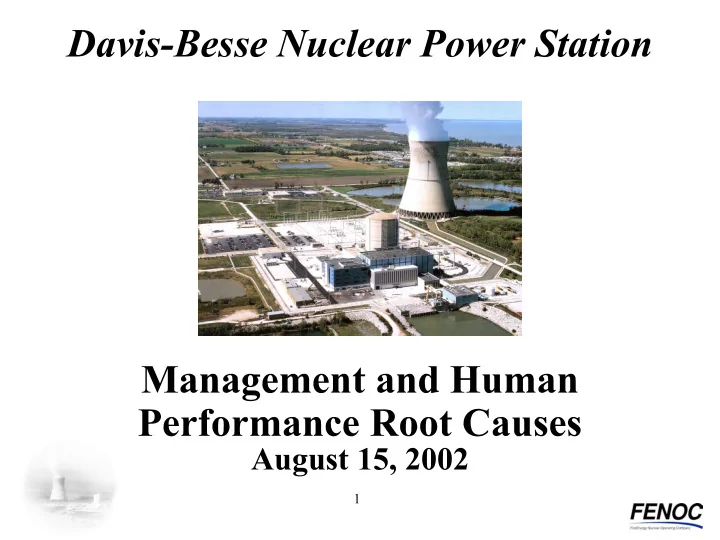

Davis-Besse Nuclear Power Station August 15, 2002 1
Introduction FENOC Chief Operating Officer 2
• Introduction - Lew Myers, FENOC Chief Operating Officer • Management and Human Performance Root Causes - Steve Loehlein, Root Cause Analysis Team Leader • Corrective Actions and Summary - Lew Myers, FENOC Chief Operating Officer 3
Discuss the root causes: • Management Oversight • Corrective Action Program • Technical Rigor • Program Compliance And the key corrective actions to be taken 4
Introduction • Earlier Root Cause investigation and the NRC Augmented Inspection Team report both concluded that management had ineffectively implemented processes, and thus failed to detect and address plant problems as opportunities arose • Root Cause Analysis Team was tasked to determine WHY the significance of the conditions in the plant was not recognized 5
Introduction Team Composition • Technical Root Cause Analysis Team Leader • Root Cause Qualified FENOC Employees • FENOC Oversight Support • Process Expertise (Conger & Elsea) • Davis-Besse Management Personnel Industry Input • Root Cause Process Experts • Organizational Effectiveness Experts • Organizational Development Consultants 6
Introduction Root Cause Team Root Cause Analysis Team • Lead: Steve Loehlein (Beaver Valley) • Bill Babiak (Perry) • Mario DeStefano (Perry) • Randy Rossomme (Beaver Valley) • Lesley Wildfong (Conger & Elsea) • Bill Mugge (Davis-Besse) • Joe Sturdavant (Davis-Besse) • Bobby Villines (Davis-Besse) • Dick Smith (Conger & Elsea) • Dorian Conger and Ken Elsea (C&E) • Spyros Traiforos 7
Root Cause Analysis Team Leader 8
Problem Statement Understand why, over a period of years, Davis-Besse personnel failed to identify corrosion of the Reactor Pressure Vessel Head base metal 9
Root Cause Statement There was less than an adequate nuclear safety focus – There was a focus on production, established by management, combined with taking minimum actions to meet regulatory requirements, that resulted in the acceptance of degraded conditions 10
11
Approach • Scope Development – Technical Root Cause results provided clues � Errors occurred over several years, and in several areas * Program effectiveness needed to be assessed * The potential for boric acid to cause damage was an issue for the plant in 1998/99, but actions taken then did not result in detection of head corrosion 12
In-Depth Evaluations • Event and Causal Factors chart and Barrier Analysis techniques used • Management Oversight and Risk Tree (MORT) technique used • MORT Analysis Sections – Technical Information Systems – Corrective Action Program – Hazard Analysis Process – Task Performance Errors – Management Support / Oversight • Corrective Actions based on conclusions of data analysis 13
Data Sources • Technical Root Cause Analysis Report • Interviews (more than 120) • Documents (approximately 700) • Over 20 years of Data 14
15
Presentation Sequence of Data Analysis/Results 1. Boric Acid Corrosion Control and Inservice Inspection (ISI) Programs 2. Handling of Technical Information 3. Corrective Action Program 4. Hazard Assessment Process 5. Management Oversight/Risk Assessment 16
Boric Acid & In-Service Inspection Programs • Hazard-Barrier-Target Analysis evaluated the Boric Acid Corrosion Control and Inservice Inspection (ISI) Programs � Model assumes that boric acid is the hazard, and the RPV head is the target � Barriers included design, training, inspection for leaks and corrosion, cleaning, and corrective actions (nearly 50 in all) 17
Conclusions • The failure to clean the RPV head (a failed barrier in the analysis) prevented the team from analyzing the behavior that would have resulted had a bare head inspection been preformed • The RPV head was not a focus in the process • None-the-less, had the programs been followed as required, they were adequate to have prevented the serious head damage 18
Handling Technical Information • Evaluated using MORT analysis technique - Evaluated the process the plant used to ensure that technical information was properly assessed and incorporated 19
Conclusion • The process for disseminating and incorporating technical information was adequate • Personnel failed to correctly apply key industry information and plant knowledge about the potential harmful effects of boric acid 20
Corrective Action Program • Utilized MORT technique and Change Analysis • Examined critical steps in process - Initiation - Operability Review/Categorization - Cause Analyses - Corrective Actions - Trending/Effectiveness Reviews 21
Conclusion • Davis-Besse adequately identified and documented nonconforming conditions • Personnel at ALL levels did not effectively implement the Corrective Action Process � Operability/operational impact underestimated � Categorization did not recognize significance � Shallow cause analyses � Inadequate corrective actions � Inadequate trending of recurring equipment problems 22
Hazard Assessment Process • Evaluated using MORT analysis technique • Examined how the organization used it to recognize and evaluate nuclear safety risks • A key focus was on the application of the process for evaluating issues subject to 10CFR50.59, Safety Evaluations 23
Conclusions • Hazard Analyses process contained the necessary elements to ensure the design and licensing basis was maintained • Process that required detailed analysis became less restricted over time � Result was that in later years, the process was not applied to Containment Air Coolers, Radiation Monitor Filters, or boric acid on RPV head 24
Management Oversight/Risk Assessment • Started from Technical Root Cause Analysis Report – Timeline of Key Events (Figure 26) from that report provides insight – Plant conditions provided clues that problem existed * Reactor Coolant System unidentified leak rate * Containment Radiation Monitor Filter plugging * Containment Air Cooler cleaning frequency * Boric acid accumulations on the head 25
Management Oversight/Risk Assessment (continued) • Examined 22 Condition Reports (PCAQRs & CRs) – Operability/operational impact underestimated by engineering and operations – Low categorization, with no root cause analysis required – Shallow cause analyses with focus on resolving symptoms rather than cause – Corrective Actions deferred resolution or treated symptoms – No collective significance recognized or evaluated; no visible senior management sponsorship 26
Recommend
More recommend